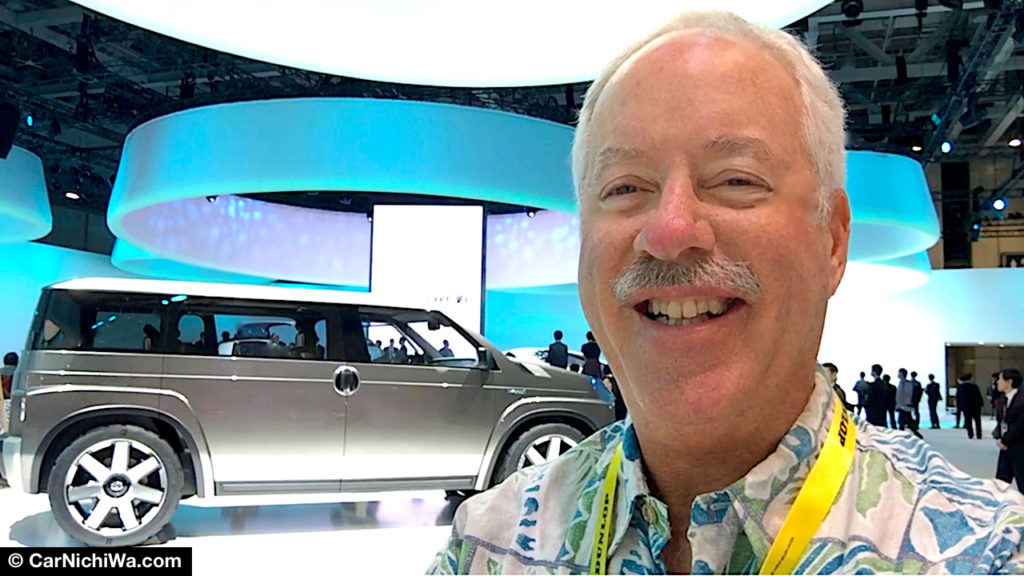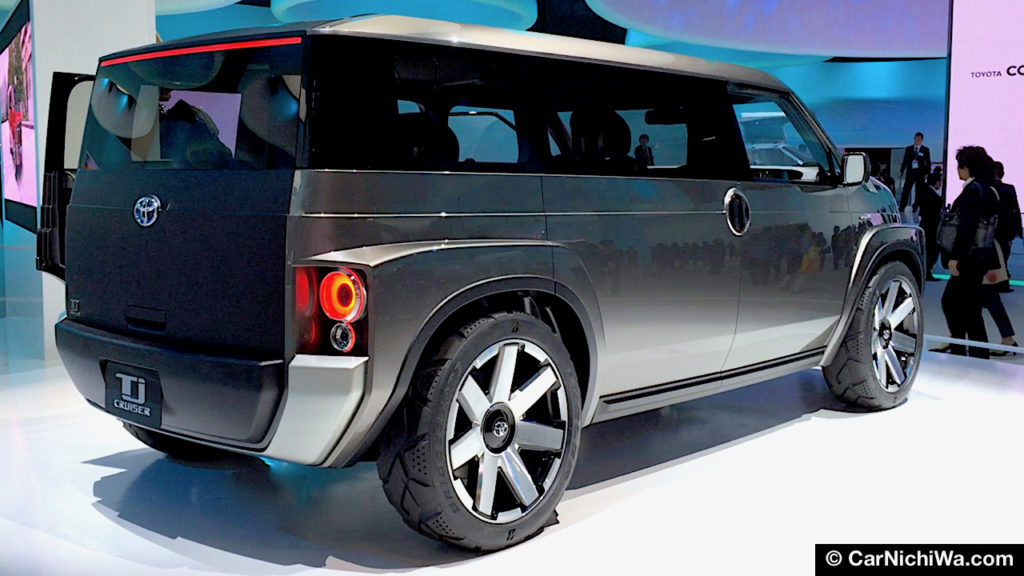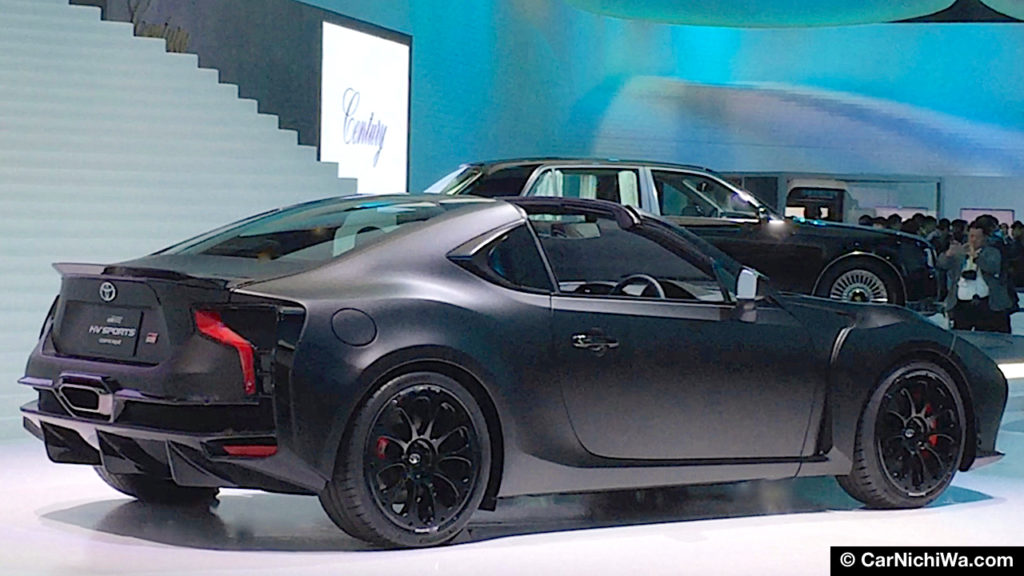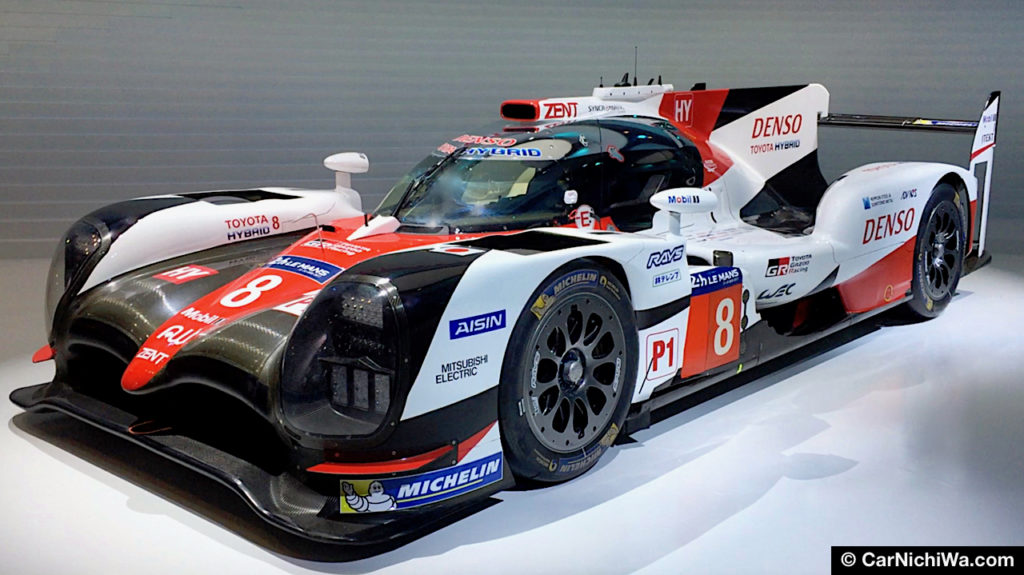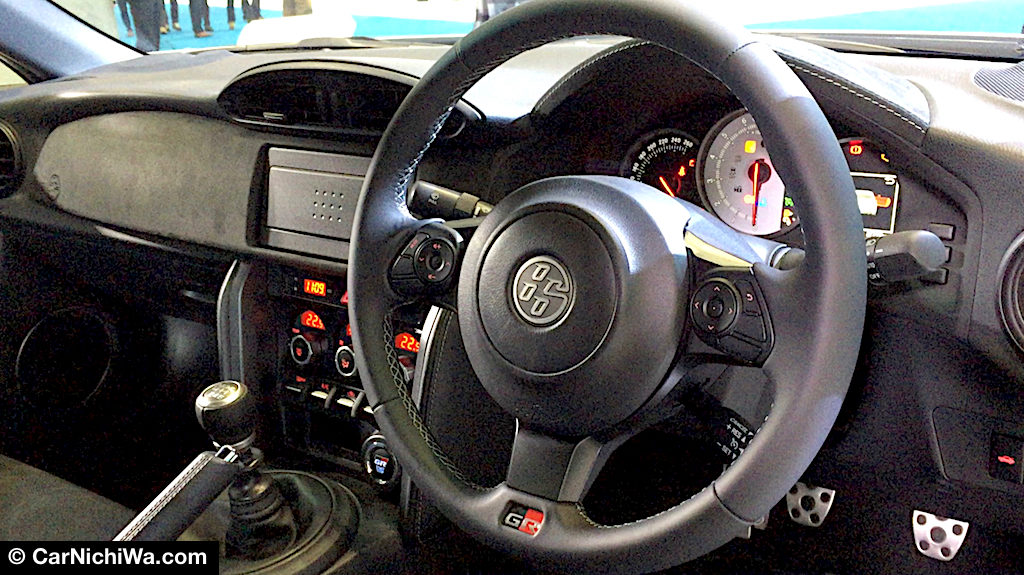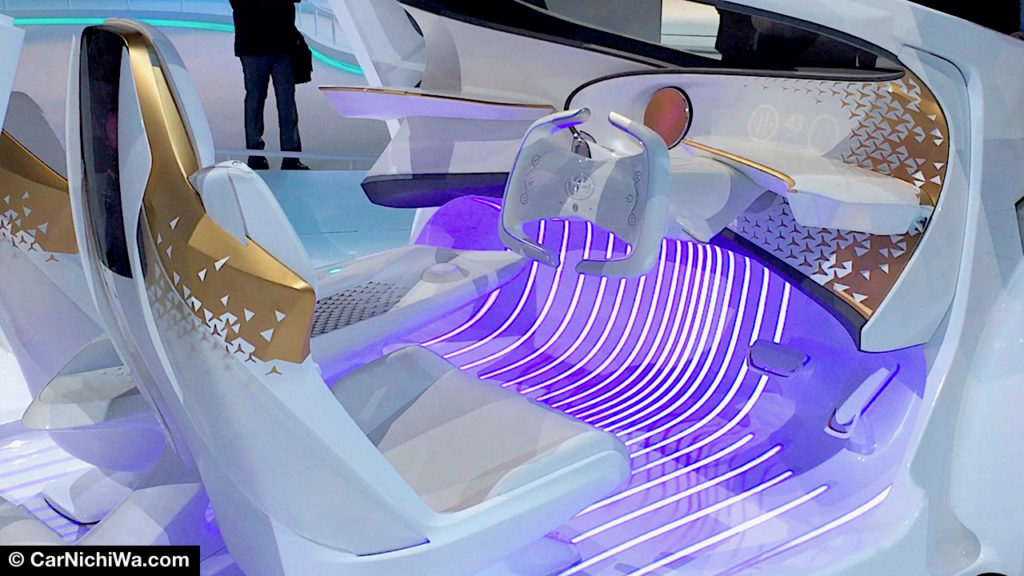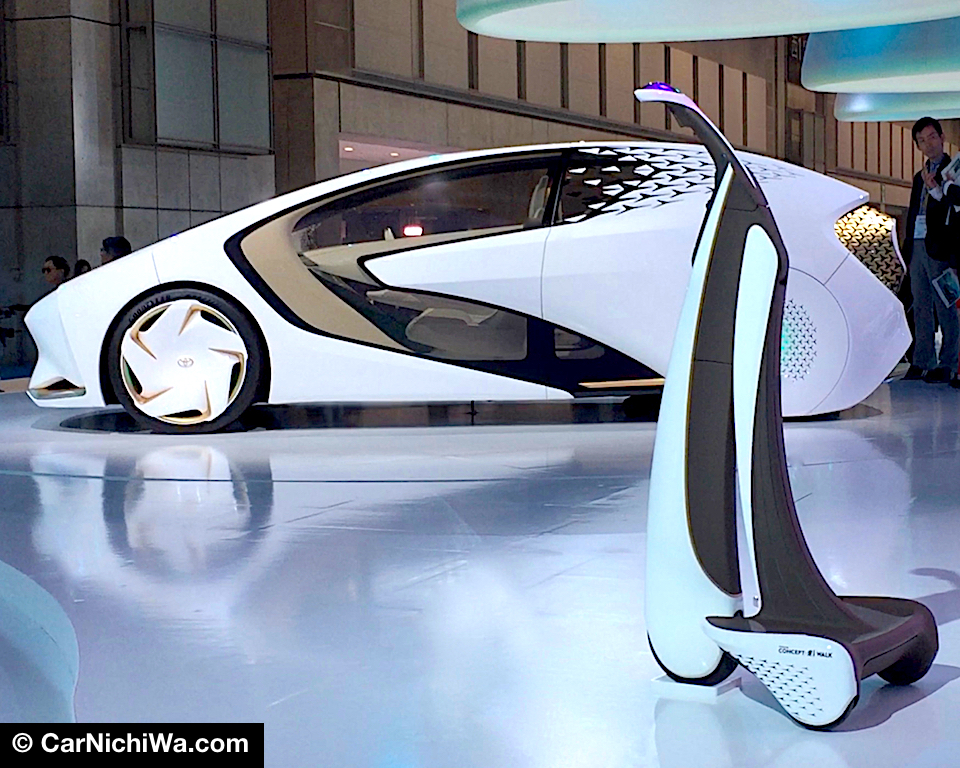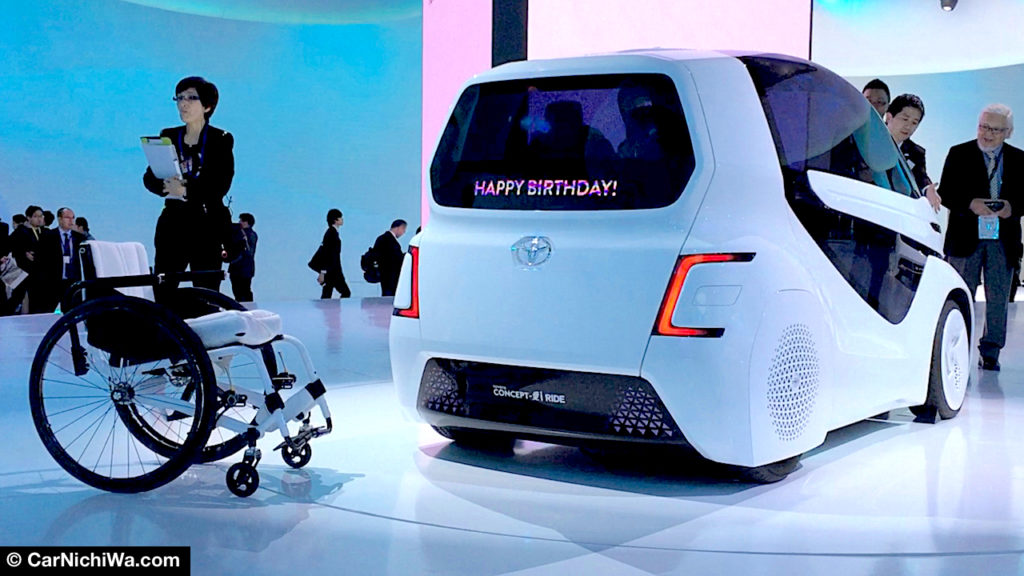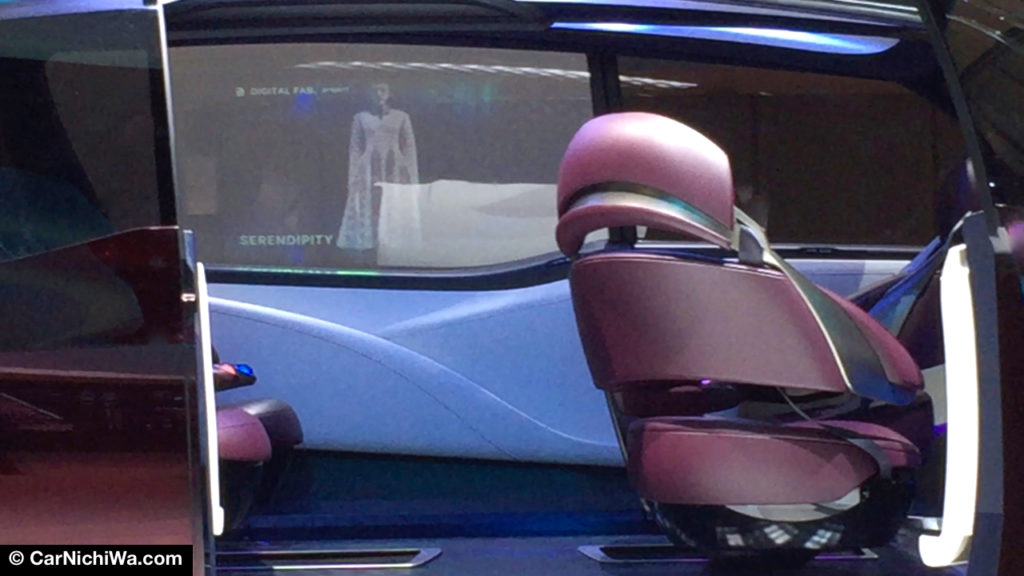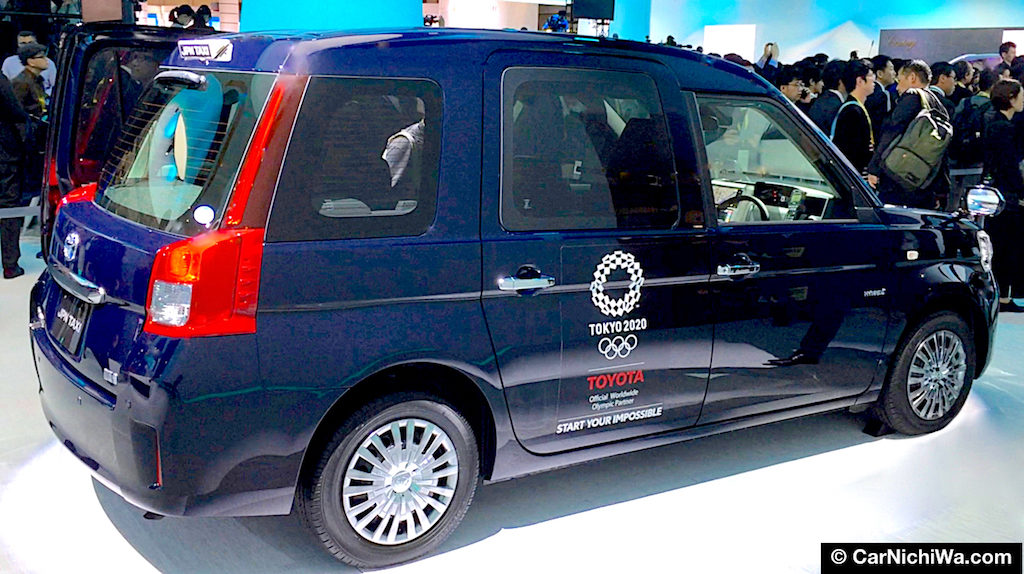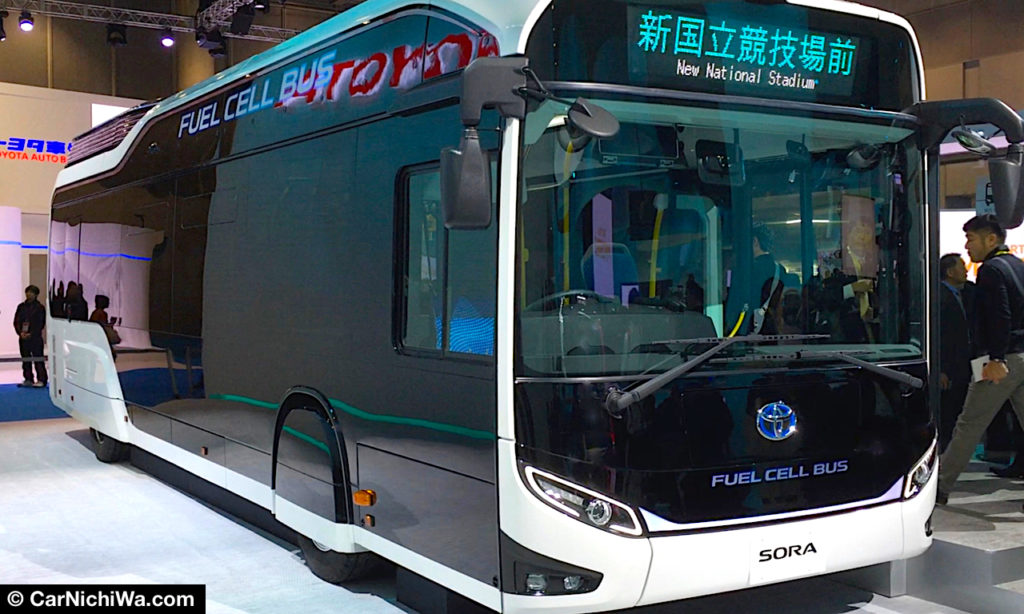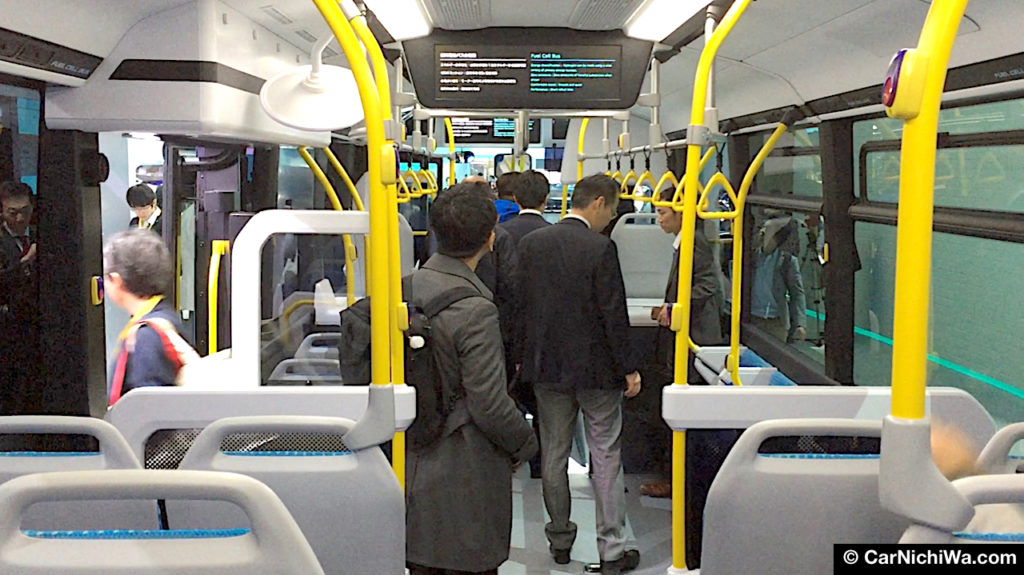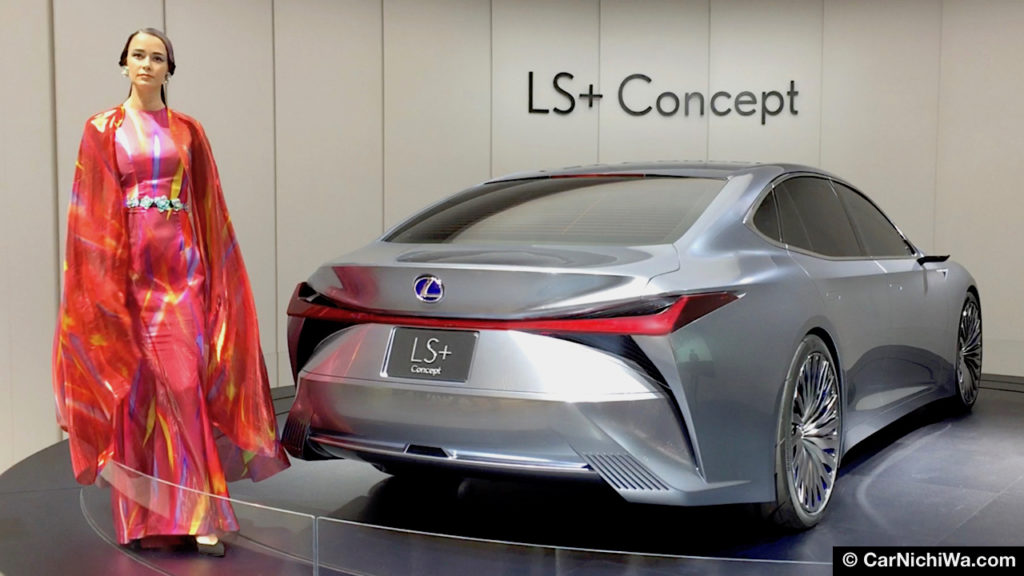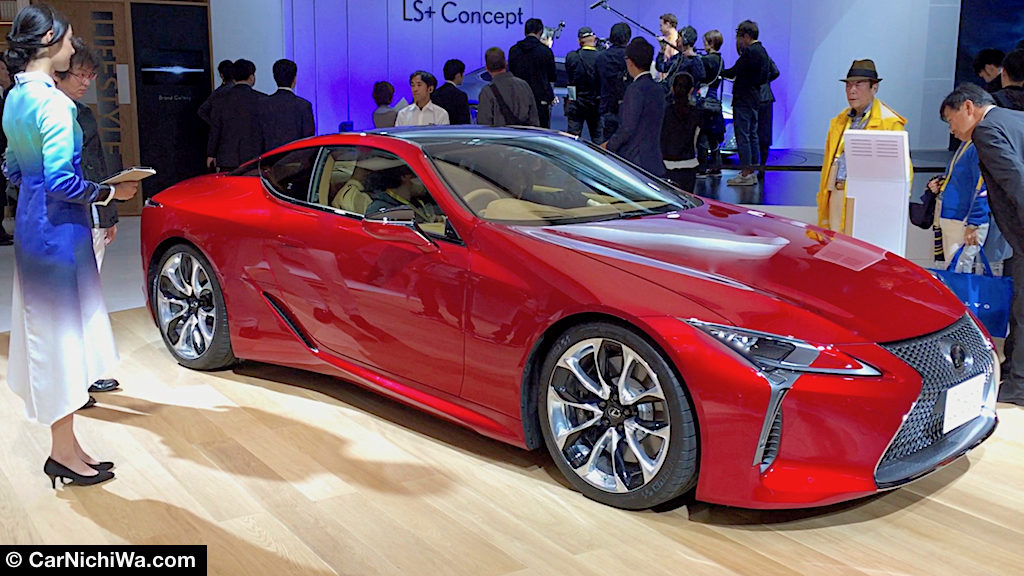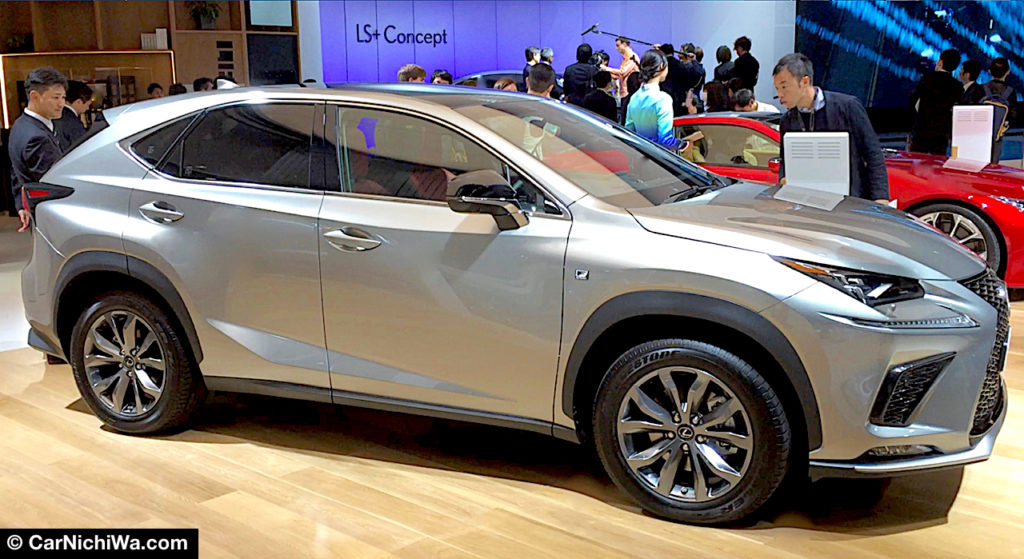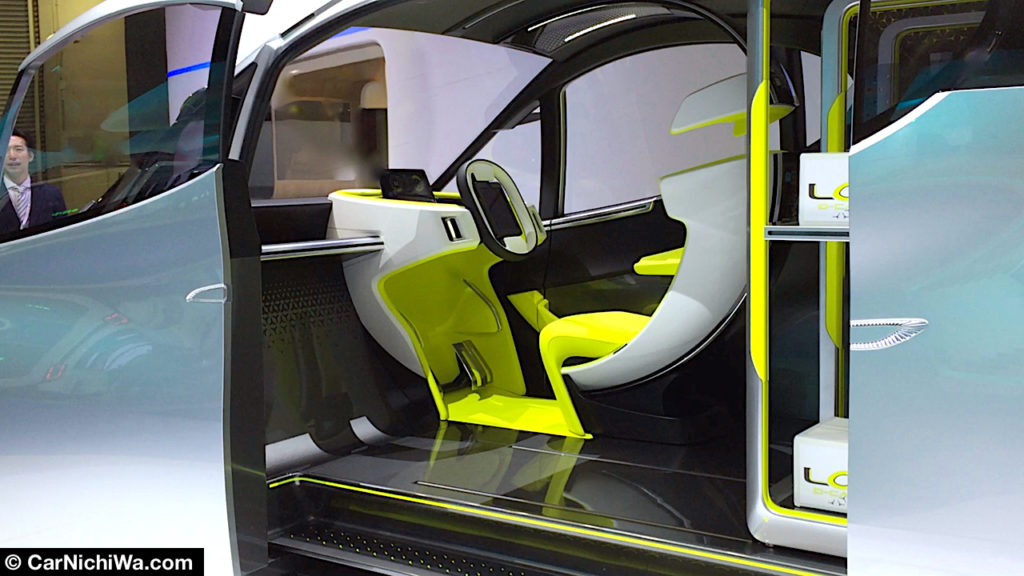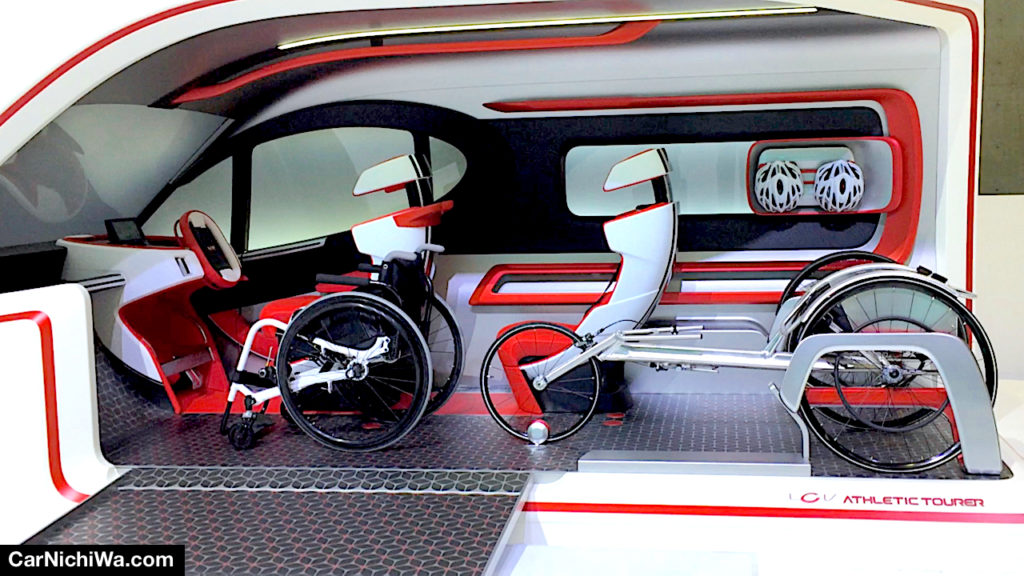By Steve Laser reporting from Tokyo, Japan
During the past 24 years, we’ve been to the biennial Tokyo Motor Show 11 times. This year’s show is filled with a wide array of new concept vehicles and production models for the Japanese market. It also focuses on the future with the theme “Beyond the Motor.”
Your faithful editor flew to Narita airport from Los Angeles on Japan Airlines. There was a minor flight delay due to a typhoon moving across Japan. Yet even a large storm couldn’t dampen his enthusiasm for the show. He arrived at Tokyo Big Sight convention center at 6:30 am on the first press day to get a good spot in line. Let’s begin our series of show stories with Toyota, Lexus and Toyota Auto Body.
Toyota
Toyota’s press conference was the first of the day, scheduled to begin at 8:30 am. Your editor waited in a line with hundreds of journalists from across the globe to attend this event.
Watch highlights of Toyota’s Tokyo Motor Show press conference (in our above video) led by Didier Leroy, executive vice president and member of the board, Toyota Motor Corporation.
The presentation highlighted Toyota’s Global Vision, along with launching a new corporate initiative inspired by Toyota’s partnership with the Olympic and Paralympic Games. “Start Your Impossible” is a clever, memorable tagline Toyota has started using leading up to the 2020 games in Tokyo. Now, let’s take a look a closer look at the vehicles on display.
Toyota says the new TJ Cruiser concept represents a “harmonious balance between the roominess of a cargo van and the design of an SUV.” Check it out in our above video.
With the FJ Cruiser finally driving into the sunset (it’s still being built in Japan), Toyota is exploring future alternatives for a small, rugged crossover. For TJ, the “T” stands for “Toolbox” and the “J” for “Joy.”
The TJ’s passenger seats fold flat, offering enough space to stow a 3-meter long surfboard or bikes. The cabin is built with rugged-looking materials while some of the exterior body panels are specially coated to help resist scratches.
We don’t know if the TJ Cruiser would make it to production sporting the van-style sliding doors. However, Toyota says something like TJ could ride on the current TNGA platform that’s used for the Prius and new C-HR. Under the hood a 2.0-liter class engine and hybrid system that transfers power to the front or all four wheels could be offered.
We captured Toyota’s new GR HV Sports concept in our above video. This car looks really cool in person and reminds us of a cross between the current Toyota 86 and previous Supra models.
While we were hoping to see a next-generation Supra at this year’s show, Toyota’s instead introduced a new concept called GR HV Sports. The “GR” stands for Toyota Gazoo Racing, while the “HV” (we think) signifies Hybrid Vehicle. Design cues include stacked rows of LED headlights, big alloy wheels, a rear diffuser and centrally mounted exhaust. While Toyota’s previous sporty concepts were painted bright red (FT-1) and yellow (SF-R), this one is dressed in stealthy matte black.
At first glance, the new GR HV Sports looks like a larger Toyota 86. However, this rear-drive two-seater is longer and wider while also featuring a hybrid powertrain. The driver can select “P-R-N-D-M” from the auto transmission using racing-style buttons mounted on the center panel and use the floor shifter with its H-style gate to shift manually.
Toyota says the design of GR HV Sports is reminiscent of Gazoo Racing’s TS050 Hybrid WEC racer (shown above at the show), while a targa top brings to mind the classic Sports 800 (Yotahachi) and Supra.
Take a look at the new Toyota 86 GR edition in our above video. Toyota says this car is slated to go on sale this winter in Japan.
A new series of sporty “GR” cars has launched for the Japanese market. GR and GR Sport are available for the compact Vitz while GR Sport will be offered for the Prius PHV, Harrier, Mark X, Voxy, and Noah.
Vitz GRMN, 86 GR, Aqua GR Sport, and Prius Alpha GR Sport models are planned to be added later. The Vitz GRMN is scheduled for release in spring 2018 while 86 GR, Aqua GR Sport, and Prius Alpha GR Sport are slated to go on sale in Japan this winter.
Special equipment planned for the 86 GR includes an aero body kit, shock absorbers by Sachs, Recaro seats, Rays forged alloy wheels, 6-pot front and 4-pot rear brake calipers, a single exhaust and a Torsen-type Limited Slip Differential. Under the hood is the current production model’s 2.0 liter horizontally opposed 4-cylinder engine.
Fast-forward to the future and something like Toyota’s trio of Concept-i vehicles might be seen on the streets of Japan. Meanwhile, we take a quick look at all three concepts in our above video.
Toyota says the Concept-i series “embodies the future vision of a mobility society through which artificial intelligence (AI) enables cars to understand the driver, effectively allowing people and cars to become partners.” The largest Concept-i (above and below) was shown earlier this year at the 2017 International Consumer Electronics Show (CES).
Toyota says Concept-i “combines technology that understands people (“LEARN”) with automated driving and agent technology, and provides drivers with safety and peace of mind (“PROTECT”), plus new Fun to Drive experiences (“INSPIRE”).”
The futuristic cabin has a forward-projecting silhouette and advanced HMI (Human Machine Interface), as well as interactions with Agent to “achieve a new user experience.” Toyota says it plans to conduct road tests of vehicles equipped with some of the concept’s high-tech gear in Japan around the year 2020.
The new i-Walk concept (above) sports a compact size designed to be used in walking areas. Toyota says it also includes an automated driving function to increase range of movement. Three wheels, a variable wheelbase, steering, and a low floor are designed for ease of use while riders can wear regular street shoes.
The new i-Ride (above) has gull-wing doors, a power universal sliding seat, and a joystick, all designed for operation by users of wheelchairs. The joystick eliminates a steering wheel, and accelerator and brake pedals, while the vehicle’s compact size allows for easy parking.
Toyota’s new Fine Comfort Ride (see our above video) was designed to highlight the design direction for a fuel-cell vehicle of the future.
While Toyota’s current Mirai Fuel Cell Vehicle (FCV) looks a bit like a Prius, the new Fine Comfort Ride concept looks like nothing else we’ve seen. Toyota says it features a flexible layout, adopts in-wheel motors, positions the wheels at the corners of the vehicle and uses underbody covers.
The cabin design is based on the concept of “wearing comfort (being wrapped in comfort).” The Agent function and touch display are positioned around the driver and passenger seats (we tried to capture the display in our video). Fine-Comfort Ride’s flexible seating can be repositioned to create individual space or communication space.
This video highlights four new Toyota concepts including the luxurious Century sedan, sporty Crown, functional JPN Taxi and Sora FCV bus.
Before there was Lexus, Toyota built cars like the flagship Century sedan. It’s been in production for generations without changing its boxy design too much. The new Century concept retains its stately proportions while adopting modern touches including a 5.0-liter D-4S Direct Injection 4-stroke gas V8 engine and THS II Toyota Hybrid System.
Those riding in the rear seat can enjoy an adjustable power leg rest and adjustable seats with massage. An LCD panel in the center armrest controls the seats, air conditioning, and audio system.
Crown was Toyota’s first model line exported to the U.S. in the late 1950s. Production of the nameplate continued in Japan with new generations of modern cars (that could wear Lexus badges). The new Crown concept at the show previews an upcoming model for the showroom based on Toyota’s TNGA architecture. High-tech features include a new DCM (Data Control Module), automatic braking, ITS Connect and remote vehicle diagnostics.
Toyota’s boxy JPN Taxi is going on sale at Toyota and Toyopet stores in Japan. The new model features a people-friendly design with a tall roof, wide-opening doors and room for a wheelchair inside. Toyota plans to use a fleet of these taxis to greet visitors to Japan in 2020, when Tokyo hosts the Olympic and Paralympic Games.
While there’s a separate area at the Tokyo Motor Show for commercial vehicles, Toyota parked this big new Sora Fuel Cell Bus at its main car display. It previews an upcoming commercial bus model slated for production next year. Toyota plans to run about 100 Soras in the Tokyo metro area, prior to the Tokyo 2020 Olympic and Paralympic Games.
Stepping inside and taking a seat is easy in this well-designed bus. Sora employs the Toyota Fuel Cell System (TFCS), originally developed for the Mirai. Sora’s upgraded powertrain is said to have no CO2 emissions or Substances of Concern (SoC) emitted when in operation.
Sora is fitted with a high-capacity, high-output external power supply system. Toyota says capacity of electricity supply (9 kW maximum output, and electricity supply of 235 kWh) could potentially be used as an emergency power source.
Lexus
In just a few short years, Lexus has transformed its model lineup with stunning new designs including the NX and RX crossovers and the just introduced in Japan flagship LS sedan. At Tokyo, Lexus revealed what could preview an LS of the future via a new concept called LS+.
What will the luxury car of the future look like? We wouldn’t be surprised if it resembles the new Lexus LS+ concept that debuted in Tokyo. Take a closer look in our video above.
Filled with high-tech goodies, Lexus says the LS+ concept does indeed indicate a “future image” of the LS sedan. Advanced styling and automated driving technologies in the concept are said to be planned for a production model around the year 2020.
We like the dynamic styling and “laser” headlights on the concept although we don’t know if something like the electronic side mirrors will be production ready by then.
LS+ employs “Highway Teammate” automated driving technologies, which are also planned for use around 2020. Lexus says functions such as automated merging, lane changes and diverging, as well as keeping a vehicle in its lane and maintaining vehicle-to-vehicle distance are possible.
The LS+ concept can communicate with a data center to update its systems’ software. Meanwhile, AI “learns from big data,” including road information and surrounding areas. Thus, the car can “learn and grow along with its users, representing a new age for the image of cars to which people can become emotionally attached.”
At the Tokyo Motor Show, we had a first look at the Japan-market model of the new LS. (We also like the cool suit worn by the vehicle presenter.)
The new Lexus LS rides on the GA-L platform, features a driver-focused interior, plus luxurious and comfortable space for passengers. A new 3.5-liter twin-turbo V6 is offered with 10-speed direct-shift transmission. Also available is a multi-stage hybrid with a gas engine and expanded range of EV driving.
Other available features include 28-way adjustable driver’s seat, Lexus Climate Concierge, air controlled suspension, Hybrid Navigation System and Mark Levinson sound. The Lexus Safety System A+ includes a wide array of safety and driver assist technologies.
The stunning Lexus LC coupe looks great in red. We recently spent a week test-driving an American-market model on the streets of Los Angeles. Our review of the LC 500 can be found at this link.
Lexus previewed two upcoming production model variations for Japan at the Tokyo Motor Show: the 10th anniversary limited-edition RC F and GS F.
These limited-edition cars, commemorating the 10th anniversary of the Lexus “F” models, are fitted with features including performance shocks and lightweight titanium mufflers. CFRP (carbon fiber-reinforced plastic) is used on some exterior components while body panels are finished in matte gray. Special interior treatments are also included.
Lexus displayed nearly its full lineup of Japanese market vehicle at the show including the NX (above), LX, RX and CT. Remember the HS? Lexus also offers the HS 250h, along with turbocharged versions of several other models.
Toyota Auto Body
We always enjoy visiting the separate display of Toyota Auto Body, makers of vehicles including the Toyota Alphard, Vellfire, Estima, Voxy, Noah, Esquire and Hiace vans plus the Coaster bus. (We tested a Toyota Voxy in Nagoya earlier this year.) Do you know that TAB also builds the Land Cruiser 200 and Lexus LX 570, along with the Land Cruiser 70 hardtop and pickup?
We liked the sporty design of TAB’s new concept dubbed LCV D-Cargo. Take a look at that and the Wonder-Capsule concept in our above video.
As a major builder of vans, TAB showcased the new LCV concept series at the show. We’re hoping that this might preview the design direction of an upcoming production model (our speculation). The D-Cargo concept has a wide-opening sliding door and low, flat floor for ease of use.
The driver is treated to a shell-style cockpit fitted with a removable tablet terminal in the center of the steering wheel to provide delivery information at a glance. Meanwhile, rear doors are divided into upper and lower portions for use in narrow parking spaces.
Two additional variations of the LCV include the Athletic Tourer Concept (above) that was previewed with a full-size styling buck. This is designed for wheelchair athletes along with easy transport of competition gear. Another interior spin highlighted the “Business Lounge Concept” equipped with limo-style seats and video conferencing capability.
TAB’s new Wonder Concept vehicle also debuted in Tokyo. TAB imagines a personal mobility vehicle for city use including ride sharing. An upright windshield offers a panoramic view and also serves as a display screen for passengers, while there’s convenient storage space behind the seats.
Visit the following links for our additional stories:
2017 Tokyo Motor Show Part 2 – Nissan, Honda, Mazda, Subaru and Mitsubishi
2017 Tokyo Motor Show Part 3 – Suzuki, Daihatsu, Isuzu, Yamaha and Tokyo Connected Lab
CarNichiWa.com thanks the Tokyo Motor Show for providing us with press passes to the media preview days. We also thank Toyota Motor Corp., Lexus International, and Toyota Auto Body Co., Ltd. for access to display vehicles for this news report.
Note: Production vehicles, features, specifications and launch dates in this story apply to Japanese market models and are subject to change without notice.
Story, photos and videos © 2017 CarNichiWa.com
